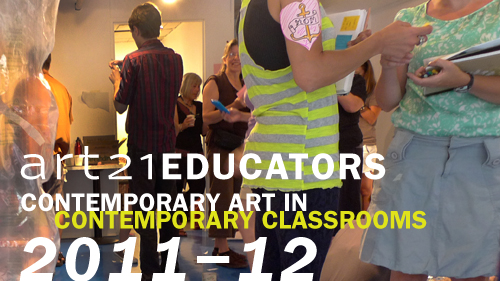Art21 is thrilled to announce the new cohort of teachers participating in the 2011-2012 Art21 Educators Program. Applicants were required to submit not only a written narrative, but also a video profile introducing themselves, their lives as teachers, and their interests. Each participant applied with a partner to provide additional support and feedback, as well as opportunities for collaborative and interdisciplinary teaching. Here is the breakdown of the new group:
- 16 teachers (8 pairs) representing Chapel Hill/Durham, NC; Burnet, TX; Chicago, IL; Brooklyn, NY; Spanish Fork, UT; Pittsburgh, PA; and Fremont, CA;
- 14 work in public schools (including 1 charter school) and 2 work in a parochial school;
- 5 of the 8 partner sets have an interdisciplinary member (representing Language Arts, Literature, Writing, Social Studies, and a generalist elementary teacher);
- There are 10 women and 6 men;
- There are 8 high school teachers, 3 middle school, and 5 elementary teachers.
Out of all the applications we received, why did we pick these 16? As a community of educators who will support each other over the course of an intensive year together, we were looking for equal parts passion and spunk, curiosity and thoughtfulness, and commitment to reinvigorating their classroom with contemporary art, artists, and ideas. In addition, we sought demographic diversity – rural, urban, suburban, West, Midwest, East, South, new teachers, and seasoned teachers. Over the next eight weeks, we will introduce you to each of the eight pairs who were chosen to participate in the third year of this unique program. Allow us to introduce the first pair of 2011-2012 Art21 Educators!
Julia CopperSmith and Maureen Hergott
Maureen and Julia teach in the Mannheim School District #83 - located about a half-hour outside of Chicago, Illinois.
Maureen Hergott has been teaching visual art for eleven years and currently teaches 1st through 5th grades at two elementary schools – Westdale Elementary School and Scott School with her partner, Julia. Maureen serves as Julia’s mentor teacher during her first year in the district. She describes how their relationship developed over the year: “we have already become great collaborators and friends. It is an amazing benefit to teach with someone with whom you can brainstorm ideas, share resources, offer guidance, and laugh.”
As part of the application, we asked Maureen to define contemporary art and describe how it relates to her teaching practice:
Defining art can be tricky, so I try to keep definitions simple and uncomplicated for my students. I explain that contemporary artists are making art right now, that they are still alive. (To which they respond, ‘then are WE contemporary artists?’ Answer: ‘YES!’). I include this point because the majority of people they are learning about in school like explorers, past presidents, or historical figures are no longer living. It fascinates them that contemporary artists are actually living, breathing people.
I explain that art and art-making has changed through the years. Contemporary artists can (and often do) create art that might not look like what my students would recognize as art. When looking at contemporary works, we have the opportunity to ask thoughtful questions and ponder the artist’s intention. Sharing and talking about contemporary art is a wonderful way to encourage my students to think outside of the box.
Julia CopperSmith has taught art for three years and is about to complete her first year teaching at Scott Elementary School. Julia says, “Scott School is a wonderful place to work. We have a very culturally diverse student body and many students are bilingual. Although it is a low-income school district, we have many resources and our administration is very supportive of the arts.”
Julia learned about Art21 in college, when one of her professors shared an episode of Art in the Twenty-First Century during class. For Julia, the series “significantly changed my perspective on contemporary art and its accessibility.” After learning about Art21 Educators, she revisited Art21’s educational resources to create lessons on collage, mapping, and printmaking for her 3rd through 5th grade art classes. Julia says, “while my students were working on these projects, I realized that showing examples of different artistic processes through these films added energy and enthusiasm to the learning environment. I have really enjoyed sharing the artists in the Art21 series with my students.”
Julia articulated clear goals for teaching in the upcoming school year and described what she wanted to accomplish through her participation in the program:
I am constantly trying to think of ways to include contemporary themes and art making practices into my teaching. I attend many professional development workshops at museums; however, the conversation about including contemporary art into the classroom is primarily directed towards high school art education. I feel it is equally important to share contemporary art within the elementary school. Through Art21 Educators, I want to learn more about how to facilitate my students’ expression through contemporary art-related lessons. Introducing contemporary art into the classroom creates a climate that promotes experimentation.
We are excited to meet Julia and Maureen this summer in New York City and look forward to hearing more about their classrooms, experiences teaching, and ideas about contemporary art. Please join Art21 in welcoming them to Art21 Educators!
